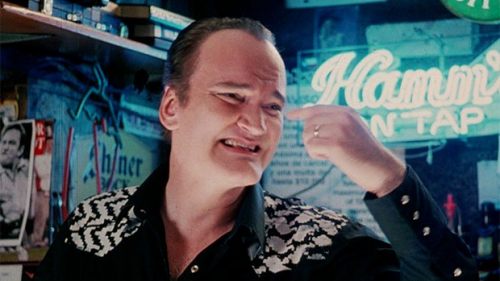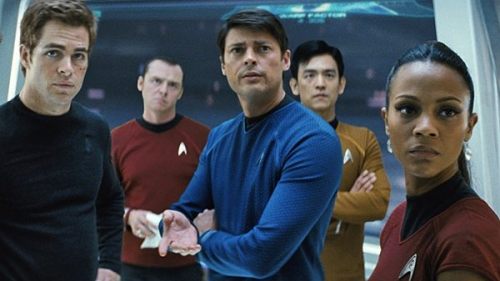A Love Letter to the Lurid: Remembering GRINDHOUSE Ten Years Later
Quentin Tarantino and Robert Rodriguez’s Grindhouse (‘07) opens with a slightly misleading definition. Though the mock double feature produced by the two auteurs was meant to emulate a viewing experience on 42nd Street during the heyday of lo-fi exploitation, the origin of the word grindhouse actually stretches back decades before the ‘70s and ‘80s. During the ‘20s, a grindhouse was a theater that showed numerous types of films on a near continuous loop – often with cartoons or ads for other flicks in-between features. They quite literally ground them out. It was an exhibition strategy invented as an alternative to traditional studio shows, which would be projected with penciled-in start times and set ticket prices per section of the theater. Grindhouses offered cut-rate entry fees that steadily rose during the day, as more reputable motion pictures were saved for the evening, in order to capitalize on demand.
Like many words in the English language, grindhouse was perverted due to age and misuse. Its meaning was first warped thanks to burlesque theaters, which were frequently positioned next to low-rent urban movie houses. In Lady of Burlesque (’43), a character refers to one of these 42nd Street risqué ports as such, resulting in public confusion regarding the term’s true application. As time trudged on, these once safe, economically-minded picture palaces became run-down dumps where producers of smutty B-Films were able to get their product played on the cheap, all while pimps, prostitutes, pushers and their respective patrons did deals in in the dark.
Film scholar Bill Landis became the premier documentarian of NYC’s trash movie scene, creating the now infamous ‘zine Sleazoid Express in June ’80. Pounding away on a manual typewriter from his room in the George Washington Hotel on 23rd and Lex, Landis self-distributed his misadventures every two weeks. The only subscription price was the cost of postage, and most of the issues were given away for free at book and record stores. Landis left his job on Wall Street and immersed himself in Times Square’s vice universe, applying the term grindhouse to both the venues and the films they showed. In the intro to his and Michelle Clifford’s 2002 recollection, Sleazoid Express: A Mind-Twisting Tour Through the Grindhouse Cinemas of Times Square, Landis describes his first gig in this arena as such:
“ …the midnight-to-8 AM projectionist at the surreal, all-male Nightshift, where hustlers from the infamous Haymarket bar across the street hung out with their customers. Muggings and bloody needles were the order of the day…”
So, now you may be closer to comprehending how Tarantino and Rodriguez opening their experiential piece of cinema with a reductive Pulp Fiction-esque classification card feels mildly disingenuous (a less generous writer may call it out-and-out bullshit). Of course, the filmmakers couldn’t air drop masturbating bums and dopesick hookers into your local Regal and completely replicate the lifestyle Landis vividly recalls from his time toiling away in the Deuce during the ‘80s. Instead, what we’re left with is the artifice of exploitation films projected at these houses of the unholy; digitally inserted film scratches and washed-out color palettes emphasizing the era both writer/directors are so obviously in love with. When combined with the mock trailers contributed by the likes of Eli Roth (Thanksgiving), Edgar Wright (Don’t), and Rob Zombie (Werewolf Women of the SS), Grindhouse becomes a love letter to a time most of these creatives never witnessed first-hand, but whose disreputable output made a lasting impact on their own filmographies. Decades after Rudy Giuliani transformed the steaming cesspool of 42nd Street into a corporate Disneyland, we were blessed with this amorous $53 million homage to a unique cinema epoch.
To be completely fair to Tarantino and Rodriguez, Grindhouse is nothing if not coming from a place of pure passion. Reportedly masterminded after the pair began holding private double and triple features from Tarantino’s legendary print collection (and then gazed longingly upon a ’57 bill for Dragstrip Girl and Rock All Night), both Planet Terror and Death Proof feel like projections of their respective creators’ explo-subgenre fascinations. Rodriguez’s Planet Terror is unsurprisingly a John Carpenter tribute, as the Austin, Texas born and bred rebel without a crew often credits an adolescent viewing of Escape From New York (’81) as the formative moment when he realized he was going to make movies. Tarantino’s Death Proof is an amalgamation of ‘80s slasher, ‘70s muscle car fetishization, and Phil Spector girl group rebel yell. It’s an extension of Jack Hill-style hangout pictures like Switchblade Sisters (’75), which Tarantino himself re-released under his short-lived Rolling Thunder Pictures label.
What’s most remarkable about Planet Terror – a movie that’s supposed to be shoddily produced and then butchered via years of print abuse – is that it’s arguably the most tightly constructed entry into Rodriguez’s oeuvre. Full of roaring guitars, horror film synths, and explosive zombie set pieces, the barely-there narrative (revolving around a tony Texas town that’s been invaded by a rage-inducing virus) only serves as an in for the two-gun madman to indulge his gonzo sensibilities. But beyond his visual acumen being flexed to its full potential (something Rodriguez hadn’t done since Desperado [‘95] or From Dusk Till Dawn [‘96]), the script he penned is full of colorful set-ups and payoffs that are organic and earned. Sure, the best gag comes from a “missing reel” jump cut that omits a metric fuckton of exposition, yet Planet Terror is alive and kicking with legitimate texture, and a cast of characters who seem to pop up in one scene, only to be dispatched two later.
This collection of cartoon misfits more than makes up for the fact that Planet Terror most certainly feels like the product of an artist who’s trying his hardest to make what he thinks an ‘80s exploitation movie felt like, as opposed to what they actually were. Josh Brolin tears into scenery as the nefarious Doctor Block, a snarling emergency room madman who thinks his needle-wielding bisexual wife (Marley Shelton) is fixing to leave him for her former lover (Fergie). Freddy Rodriguez goes full Snake Plissken with his gravelly voice, trying to save his go-go dancing ex, Cherry Darling (Rose McGowan), who eventually gets her leg chopped off and replaced with a large-caliber machine gun. JT (Jeff Fahey) is all blue-eyed sparkle and charm, keeping his secret BBQ recipe safe from his Sheriff brother (Michael Biehn), even as their world begins to burn. The army forces these Texan goofs run in with are led by a stern black ops Lieutenant (Bruce Willis) aligned with a terrorist (Naveen Andrews) whose chemical weapon is transforming all it comes in contact with into mindless, rampaging ghouls. In a way, Planet Terror is a natural continuation of the work Rodriguez performed with Frank Miller on Sin City (’05)– a veritable fan film that sees him warping famous faces into twisted visages fit for the pages of Fangoria magazine.
As entertaining as it is, the jokiness of Rodriguez’s delivery is actually what undoes this attempt at crafting a genuine exploitation movie. There’s a winking self-awareness to every line delivery that takes you out of even the movie’s most intense moments. Blood squibs and CGI gore explode like volcanoes every time someone is shot or stabbed. Wounds ooze and erupt with puss. Gross-out comedy is handled with the subtlety of a Troma production, and more resembles trash art parodies like Black Dynamite (’09), or Rodriguez’s own Machete duology (direct spin-offs of this movie’s opening fake teaser). Does this render Tarantino and Rodriguez’s movie any less of a ball to sit through with a cheering crowd? No way, Jose. But it does somewhat undermine the intent of replicating an authentic flop house experience. Legit exploitation movies didn’t acknowledge that they were bad or outrageous because they didn’t necessarily know they were bad or outrageous. Instead, those cheapie filmic scabs were engaging, thrilling or subversive despite the obvious limitation of resources and talent displayed onscreen.
Even upon initial release, many who praised Grindhouse agreed that the mock trailers that separated the two “features” were a highlight of this 191-minute trip to the movies. However, these spots are something of a double-edged sword – as all three (not to mention the literal sizzle reel for Acuna Boys Tex-Mex) are indeed side-splitting, but only push this grand experiment further into parody territory. Rob Zombie’s Werewolf Women of the SS features all his usual players – Bill Moseley, Sheri Moon-Zombie, Sid Haig – and definitely displays a knowledge of Don Edmonds softcore Nazisploitaion like Ilsa, She-Wolf of the SS (’75). Yet once Nicolas Cage makes his cameo as Fu Manchu, the joke is pushed way over the top. Eli Roth’s Thanksgiving layers music from George A. Romero’s Creepshow (’82) over perfectly imitated slasher aesthetics that harken back to Canadian slice and dice fare like My Bloody Valentine (’81). Nevertheless, the authenticity ends once “The Pilgrim” murderer starts fucking the “turkey” (you gotta see it to believe it). Edgar Wright’s Don’t utilizes Will Arnett’s voice-over skills to sell its play on retitled Eurotrash, but it’s a one note gag that’s clearly a gag. Again, the 90-second blips effectively entertain, but possibly not in the way legit hucksterism (like this classic bit for I Dismember Mama [‘72]) from the period it’s acknowledging did.
By ‘07, Tarantino had been writing and directing two different types of motion pictures – those set in his hyper-violent “real world” (True Romance, Reservoir Dogs, Pulp Fiction, Jackie Brown) and those he deemed “grindhouse fantasies” (From Dusk Till Dawn, Kill Bill). Think of it this way: if Marsellus and Mia Wallace went out on a date, they’d probably be tempted to buy a ticket to The Bride’s latest samurai adventure at the New Bev. Death Proof perfectly fits into the latter category – his Swinging Barmaids (’75) setup ending in grisly murder for these beautiful bubbly babes once they run afoul of Stuntman Mike (Kurt Russell) and his jet black, four-wheeled instrument of misogynistic chaos. Where QT convinced the Weinsteins to pay for him to travel overseas and learn how to choreograph and shoot Kung Fu action sequences with Kill Bill (’03), here he’s crashing cars in Godardian fashion on their dime with an eerie show of respect to Vanishing Point (’71) and Dirty Mary, Crazy Larry (’74). This is the closest we’re probably ever going to get to pure horror from Tarantino, as he explores the hostile fragility of masculinity via the roar of a vintage automobile’s engine.
Casting Kurt Russell as Stuntman Mike may be the greatest marriage of role and performer on Tarantino’s already impressive CV. Not only does Russell smuggle historic baggage from years of being a B-Movie idol (thanks to his own Carpenter collaborations), it’s yet another opportunity for him to play the lovable goon – hiding a soft, stupid interior with a tough guy projection of manly perfection. Russell goes full Duke Wayne meets Jason Voorhees, conning his way into lap dances before shouting horrible, anti-woman insults as he decimates his victims in a haze of gasoline fumes and twisted metal. When the women finally fight back against this beast in a plain t-shirt and dark sunglasses, he folds like a cheap suit, sniveling and whining that he’s “sorry.” But by that point, it’s too late. Tarantino has long been a filmmaker fascinated with vengeance, and Russell allows himself to become a hateful avatar who’s destroyed once his weakness is revealed to be far greater than the strength his victims possess. It’s an absolute disregard for vanity that combines with Russell’s magnetic charisma to produce an all-time great movie monster. Stuntman Mike is the tyranny of evil men, and these car-loving ladies (led by the absolutely stunning Zoë Bell) are here to scrape him from their boot heels onto this two-lane blacktop.
The driving sequences in Death Proof are a marvel of practical stunt work, with Bell more than earning her reputation as one of the best in the business during the show-stopping “ship’s mast” set piece. They’re a meta-textual comment on how the tangible glory of The French Connection’s (’71) groundbreaking car chase can never be replicated by the digital fuckery of the latest Fast & the Furious sequel. However, the technical accomplishments of Tarantino’s ode to counterculture action riffs of the ‘70s are a funhouse mirror image to the jokiness that undoes Rodriguez’s own stab at genuine exploitation filmmaking. In actuality, Tarantino barely tries to emulate a grindhouse aesthetic beyond structuring his “feature” like a vintage explo trip (where “nothing happens” in its first half because the producers saved all the money to spend on the film’s volatile final reel). There are some scratches and “bad splice” jump cuts in the first forty-five minutes, but those all but disappear by the movie’s traffic-decimating climax. Unlike the overabundance of destruction slathered onto Planet Terror, Death Proof’s “celluloid” damage more accurately represents how many 35/16mm prints from the era look when projected in repertory houses today, clearing up as we get into the latter reels.
It’s accurate to describe Grindhouse as possibly the most influential failure of the last decade. Upon barely making back half its budget at American theaters, the Weinsteins split the movie and released extended “International Cuts” in every other country, ruining the experiential nature of this grand experiment. When released on home video, these protracted versions were the first to appear on American disc, causing fans to import the movie from foreign distributors in order to watch it as it was originally intended (this writer bought a multi-disc Japanese edition that included the International cuts of both Planet Terror and Death Proof, as well as Grindhouse). For a minute, it seemed as if we had another Whole Bloody Affair on our hands (the film’s since been released in its entirety on Blu). Yet there’s no denying that Tarantino and Rodriguez’s financial disaster only helped to raise mainstream awareness regarding a certain type of motion picture that was only celebrated on the fringes of cinephilia up to this point. More and more boutique home video labels (such as Vinegar Syndrome) popped up in order to try outdo each other in terms of who could release the rarest, trashiest title from the glory days of 42nd Street, resulting in a reclamation of that which would’ve otherwise been lost to format changeovers. Meanwhile, an entire “faux explo” subgenre emerged within modern filmmaking, as both straight-faced and parody pictures began being produced en masse (think: The Sleeper to Father’s Day). So, while the authenticity of Grindhouse is certainly debatable, its entertainment value and importance to film history are indisputable. By championing a morally dubious era many film historians would like to forget, Quentin Tarantino and Robert Rodriguez enabled a new generation of trash cinema aficionados. In short, they did Bill Landis proud and kept the Sleazoid Express chugging along.



